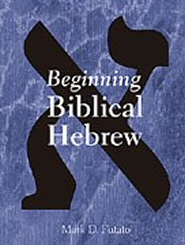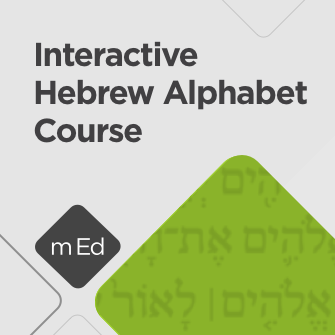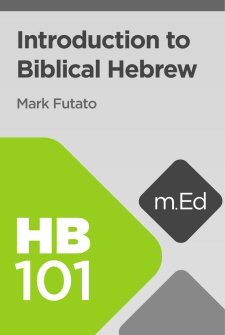Biblical Hebrew: Foundational Certificate Program
Digital Logos Edition
Overview
This bundle of Hebrew resources includes everything you need to learn how to read, translate, and understand the language of the Old Testament. The Interactive Hebrew Alphabet Courses will introduce you to the Hebrew alphabet and teach you how to pronounce Hebrew words. Introduction to Biblical Hebrew (HB101) walks you through the basics of Hebrew grammar and syntax. You’ll learn vocabulary and the various parts of speech as you learn how to translate the Old Testament. The courses are supplemented with Beginning Biblical Hebrew, an introductory Greek grammar with exercises.
This Biblical Hebrew Foundational Certificate Program qualifies you to earn a Logos Mobile Education Certificate of Completion. After working through HB101 simply submit your own translation of the first chapter of the Ruth to certificate@faithlife.com to earn your certificate.

How to Apply for a Mobile Ed Certificate of Completion
- Complete all Mobile Ed courses in this certificate program. This involves viewing all videos and taking all quizzes.
- Translate Ruth 1:1–22. Post your translation to the HB101 Faithlife group in the comments section.
- Email certificate@faithlife.com once you have completed all videos and quizzes and have posted responses in the appropriate Faithlife group for each Mobile Ed course in the certificate program. Please include your full name, title of completed certificate program, and links for each Faithlife group post in your email.
- Our certificate program team will review the application and email the Certificate of Completion once you have completed all requirements. Please allow 7–10 business days for review.
- HB091 Interactive Hebrew Alphabet Course by Mark Futato
- HB101 Introduction to Biblical Hebrew by Mark Futato
- Beginning Biblical Hebrew by Mark Futato
Included Resources
- Listen & Learn: Hebrew Interactive
- Hebrew Alphabet Tutor Interactive
- Title: Biblical Hebrew: Foundational Certificate Program
- Instructor: Mark Futato
- Publisher: Lexham Press
- Publication Date: 2019
- Product Type: Logos Mobile Education
- Resource Type: Courseware, including transcripts, audio, and video resources
- Courses: 2
- Video Hours: 11
- Volumes: 1
- Pages: 351
For serious study of the Old Testament you need to be able to recognize the original words of the Hebrew Bible since they regularly appear in commentaries and lexicons. This course will make you feel at ease when you encounter such references by teaching you the Hebrew alphabet and showing you how to pronounce whole words. To help you master the Hebrew alphabet, each lesson has an interactive activity section with various experiential exercises, such as game-type drills, an alphabet song, and quizzes. There are also reference sections with additional information and materials such as printable charts. Whether you are just curious about the alphabet or are planning to study biblical Hebrew, this course provides a fantastic foundation for recognizing Hebrew letters and words so you can work with all of the words the Lord has preserved for us in the Old Testament.
Learning Objectives
Upon successful completion you should be able to:
- Recite the Hebrew alphabet from memory
- Pronounce each letter in the alphabet
- Pronounce Hebrew words and passages
- Be able to start learning Hebrew vocabulary
Contents:
Hebrew Alphabet and Pronunciation
- Course Orientation
- The Hebrew Alphabet
- Consonants with Multiple Sounds and Forms
- Vowels
- Sheva and Dagesh
- Syllables
- Accents
- Pronouncing Words
- Reading Hebrew
Gain insight into Hebrew grammar, and learn all of the sounds and symbols of the alphabet—both the consonants and the vowels. Explore the forms of the noun, the adjective, and the verb in all its conjugations of the basic patterns. Discover how these words work together to form phrases, clauses, and sentences. As you deepen your knowledge of how Hebrew works, you will practice reading Hebrew text from the Hebrew Bible.
Learning Objectives
Upon successful completion you should be able to:
- Understand the basic parts of speech and syntax of Hebrew
- Read Hebrew from the Hebrew Bible
Contents:
Introduction
- Introducing the Speaker and the Course
Unit 1: Learning to Read Hebrew
- The Alphabet
- Consonants with Two Forms and Two Sounds
- Vowels
- Putting Consonants and Vowels Together
- Sheva and Strong Dagesh
- Unit 1 Vocabulary
- Unit 1 Practice
- Unit 1 Reading Your Hebrew Bible
Unit 2: Nouns: Basic Forms
- Gender of Nouns
- Number of Nouns
- Summary of Basic Noun Forms
- Unit 2 Vocabulary
- Unit 2 Practice
- Unit 2 Reading Your Hebrew Bible
Unit 3: Personal Pronouns and the Definite Article
- Personal Pronouns
- The Definite Article
- Unit 3 Vocabulary
- Unit 3 Practice
- Unit 3 Reading Your Hebrew Bible
Unit 4: Verbs: Perfects
- Overview of the Hebrew Verb
- Qal Perfect
- Use of the Qal Perfect
- Unit 4 Vocabulary
- Unit 4 Practice
- Unit 4 Reading Your Hebrew Bible
Unit 5: Sentences with Verbs
- Subject
- Direct Object
- Word Order
- Negative Sentences
- Unit 5 Vocabulary
- Unit 5 Practice
- Unit 5 Reading Your Hebrew Bible
Unit 6: Verbs: Seven Patterns
- Seven Basic Verb Patterns
- Niphal
- Piel and Pual
- Hiphil and Hophal
- Hitpael
- Unit 6 Vocabulary
- Unit 6 Practice
- Unit 6 Reading Your Hebrew Bible
Unit 7: Prepositions and Vav Conjunction
- Prepositions
- Independent Prepositions
- Inseparable Prepositions
- Vav Conjunction
- Unit 7 Vocabulary
- Unit 7 Practice
- Unit 7 Reading Your Hebrew Bible
Unit 8: Adjectives: Forms and Use
- Basic Forms of Adjectives
- Geminate Roots
- Use of Adjectives
- Unit 8 Vocabulary
- Unit 8 Practice
- Unit 8 Reading Your Hebrew Bible
Unit 9: Verbs: Imperfects
- Form of the Qal Imperfect
- Use of the Imperfect
- Unit 9 Vocabulary
- Unit 9 Practice
- Unit 9 Reading Your Hebrew Bible
Unit 10: Nouns: Construct State
- Use of the Construct State
- Form of the Construct State
- Unit 10 Vocabulary
- Unit 10 Practice
- Unit 10 Reading Your Hebrew Bible
Unit 11: Pronoun Suffixes
- Pronoun Suffixes on Singular Nouns
- Pronoun Suffixes on Plural Nouns
- Pronoun Suffixes on Prepositions
- Unit 11 Vocabulary
- Unit 11 Practice
- Unit 11 Reading Your Hebrew Bible
Unit 12: Verbs: Infinitives
- Infinitives
- Infinitive Construct
- Infinitive Absolute
- Unit 12 Vocabulary
- Unit 12 Practice
- Unit 12 Reading Your Hebrew Bible
Unit 13: Verbs: Participles
- Introducing Participles
- Use of the Participle
- Unit 13 Vocabulary
- Unit 13 Practice
- Unit 13 Reading Your Hebrew Bible
Unit 14: Verbs: Volitives
- Volitives
- Imperative and Jussive
- Negating and Indirect Volitives
- Unit 14 Vocabulary
- Unit 14 Practice
- Unit 14 Reading Your Hebrew Bible
Unit 15: Verbs: Vav-Relatives
- Vav-Relatives
- Use of the Vav-Relative
- Unit 15 Vocabulary
- Unit 15 Practice
- Unit 15 Reading Your Hebrew Bible
Unit 16: Verbs: Piels
- Piel
- Form of the Piel
- Piel Imperatives, Infinitives, and Participles
- Piel Cohortative and WCI
- Unit 16 Vocabulary
- Unit 16 Practice
- Unit 16 Reading Your Hebrew Bible
Unit 17: Verbs: Hiphils
- Introducing the Hiphil
- Form of the Hiphil
- Hiphil Imperative, Infinitive, and Participle
- Hiphil Cohortative, Jussive, and WCI
- Unit 17 Vocabulary
- Unit 17 Practice
- Unit 17 Reading Your Hebrew Bible
Unit 18: Verbs: Niphals
- Meaning of the Niphal
- Form of the Niphal
- Niphal Imperative, Infinitive, and Participle
- Niphal Cohortative, Jussive, and WCI
- Unit 18 Vocabulary
- Unit 18 Practice
- Unit 18 Reading Your Hebrew Bible
Unit 19: Syntax: The Perfect
- Syntax of the Perfect
- Performative, Gnomic, Precative, and Rhetorical Perfect
- Unit 19 Vocabulary
- Unit 19 Practice
- Unit 19 Reading Your Hebrew Bible
Unit 20: Syntax: The Imperfect
- Syntax of the Imperfect
- Imperfect Modalities
- Unit 20 Vocabulary
- Unit 20 Practice
- Unit 20 Reading Your Hebrew Bible
Unit 21: Weak Roots
- Introducing Weak Roots
- Unit 21 Vocabulary
- Unit 21 Practice
- Unit 21 Reading Your Hebrew Bible
Conclusion
- Finishing the Course but Not Your Hebrew Studies

Beginning Biblical Hebrew
- Author: Mark Futato
- Publisher: Eisenbrauns - EIS
- Publication Date: 2003
- Pages: 351
- Format: Logos Digital
Achieving the right balance of amount of information, style of presentation, and depth of instruction in first-year grammars is no easy task. But Mark Futato has produced a grammar that, after years of testing in a number of institutions, will please many, with its concise, clear, and well-thought-out presentation of Biblical Hebrew.
Because the teaching of biblical languages is in decline in many seminaries and universities, Futato takes pains to measure the amount of information presented in each chapter in a way that makes the quantity digestible, without sacrificing information that is important to retain. The book includes exercises that are drawn largely from the Hebrew Bible itself.
Contents:
- THE ALPHABET
- THE VOWELS
- SYLLABLES, SHEVA, AND STRONG DAGESH
- THE NOUN: BASIC FORMS
- PRONOUNS AND THE DEFINITE ARTICLE
- THE VERB: QAL PERFECT
- SENTENCES WITH VERBS
- THE NOUN: VOWEL CHANGES
- PREPOSITIONS AND VAV CONJUNCTION
- THE ADJECTIVE
- THE VERB: QAL IMPERFECT
- CONSTRUCT RELATIONSHIP: SINGULAR
- CONSTRUCT RELATIONSHIP: PLURAL
- QAL PERFECT AND IMPERFECT: WEAK ROOTS
- QAL PERFECT AND IMPERFECT: I NUN AND III HEY
- POSSESSIVE SUFFIXES ON SINGULAR NOUNS
- DEMONSTRATIVE AND RELATIVE PRONOUNS
- QAL IMPERFECT: I YOD AND I ALEF
- POSSESSIVE SUFFIXES ON PLURAL NOUNS
- THE VERB: QAL INFINITIVES
- THE VERB: QAL ACTIVE PARTICIPLE
- PRONOUN SUFFIXES ON PREPOSITIONS
- THERE IS (NOT) AND HAVE (NOT)
- THE VERB: QAL VOLITIVES
- QAL: HOLLOW VERBS
- THE VERB: VAV-RELATIVE
- CLAUSES: TEMPORAL AND INTERROGATIVE
- THE PIEL: STRONG ROOTS
- THE PIEL: STRONG ROOTSTHE PIEL: WEAK ROOTS
- NUMBERS AND “SURPRISE”
- THE HIPHIL: STRONG ROOTS
- THE HIPHIL: I GUTTURAL AND I NUN
- THE HIPHIL: I YOD
- THE HIPHIL: III HEY AND HOLLOW
- MORE ON PRONOUN SUFFIXES
- THE NIPHAL: STRONG ROOTS
- THE NIPHAL: WEAK ROOTS
- MORE PASSIVE VERBS: QAL, PUAL, AND HOPHAL
- THE VERB: THE HITHPAEL
- THE VERB: GEMINATE ROOTS
- PARADIGMS
- VOCABULARY
- ANSWERS TO PRACTICE DRILLS
Reviews
4 ratings

M.K. Kretov
11/14/2021
This is quite pricey, I’d recommend it if A. it’s on sale under $300 and B. You really need help with the discipline and interest to maintain learning. This video course is good for that, it makes the process simpler and a little fun. But if you have a strong interest and desire to learn hebrew you should find cheaper alternatives that will leave you room to purchase other supplements. THIS COURSE DOES NOT give you “everything you need to read and understand biblical Hebrew” It gives you basic you morphology (how words are built and manipulated). And it does give very little syntax (how sentences are made and how words relate to each-other), but IT IS VERY LITTLE. You will certainly need to learn more about syntax to read and translate without various helps. Pros: 1. It’s a course so self learning is easier. 2. It’s on logos so it’ll will give you more experience and skill with the software. Cons: 1. There’s little manual for what to do with the resources you get. At first I had no idea what to do and which resources were for what but this can be figured out. 2. It’s overpriced 3. The videos are basically simplified segments from the textbook. So you really could learn the same amount by diligently going through the book. 4. There are mistakes in the course, typos, contradictions between course and textbook, really annoying practice segments on subject matter you haven’t learned etc. this can be frustrating but I got through it by searching out the material. 5. The faithlife group is very inactive and unhelpful. 6. Very little syntax
Carey A Grady
10/26/2020

Fernando-Elías
9/21/2020
I love the course and the way that Mark teaches the Hebrew. The point that I don't like it much, is that the content, and some times the explanation is generally the same that you can find in his book "Beginning Biblical Hebrew". In my case I had the book in my library and I was expecting something new. The other point is that I can't save the videos in my Logos Software (computer) so I need always internet connexion to learn it. I prefer offline to learn everywhere without WiFi. Great course and great teacher if you want to start and understand Hebrew from the beginning.
Ashar Allah Ditta
8/8/2020



